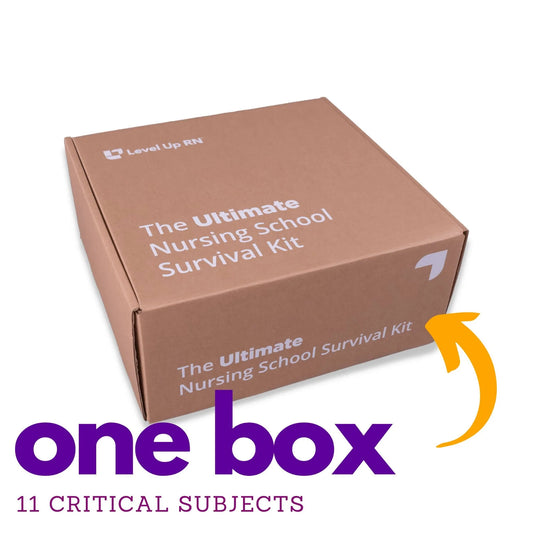Nursing Tips

Cultural Assessment
A cultural assessment involves the identification of a patient's cultural and spiritual beliefs, practices, and preferences regarding medical interventions, illness, family, diet, pregnancy, death, and postmortem care.
Cultural Assessment
A cultural assessment involves the identification of a patient's cultural and spiritual beliefs, practices, and preferences regarding medical interventions, illness, family, diet, pregnancy, death, and postmortem care.

High-Fowler's Position
A High-Fowler's position involves the patient sitting with the head of the bed at 60 - 90°. This is the ideal position to help with difficulty breathing.
High-Fowler's Position
A High-Fowler's position involves the patient sitting with the head of the bed at 60 - 90°. This is the ideal position to help with difficulty breathing.
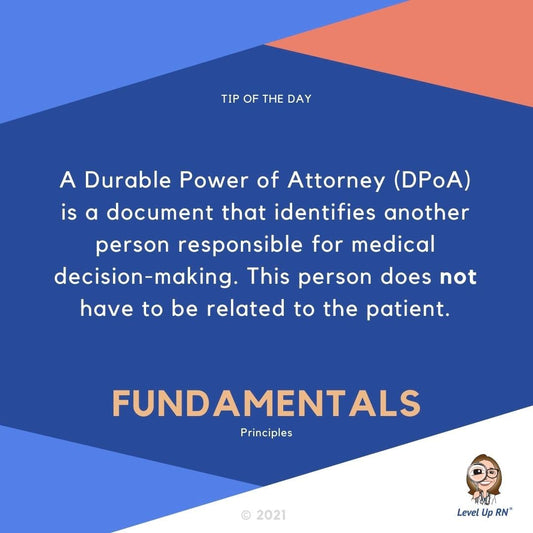
Durable Power of Attorney (DPoA)
A Durable Power of Attorney (DPoA) is a document that identifies another person responsible for medical decision-making. This person does not have to be related to the patient.
Durable Power of Attorney (DPoA)
A Durable Power of Attorney (DPoA) is a document that identifies another person responsible for medical decision-making. This person does not have to be related to the patient.
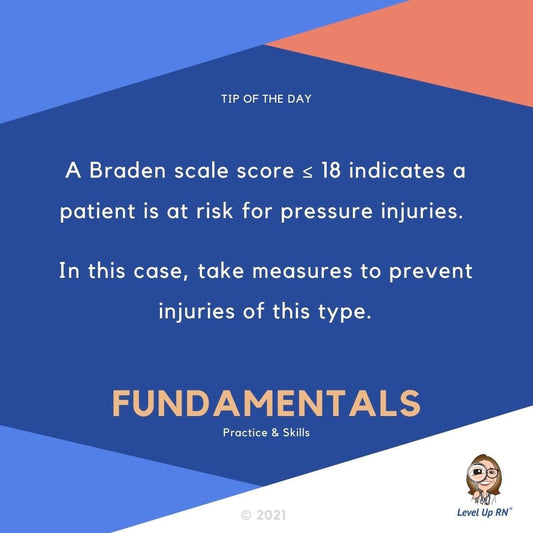
Braden Scale: Pressure Injuries
A Braden scale score ≤ 18 indicates a patient is at risk for pressure injuries. In this case, take measures to prevent injuries of this type.
Braden Scale: Pressure Injuries
A Braden scale score ≤ 18 indicates a patient is at risk for pressure injuries. In this case, take measures to prevent injuries of this type.
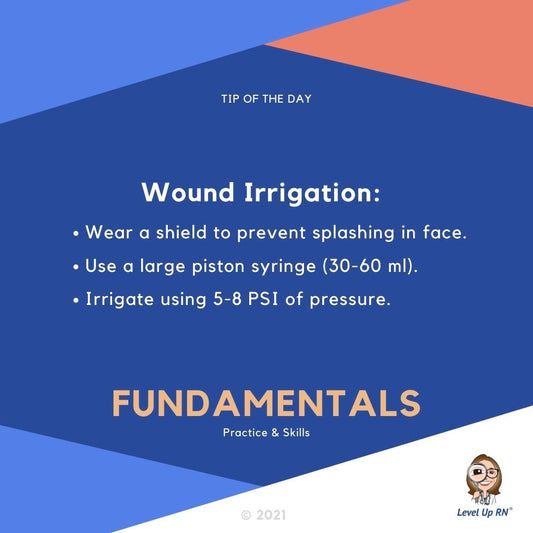

Suctioning
When performing suctioning, apply suction intermittently while withdrawing the catheter and rotating it for 10-15 seconds.
Suctioning
When performing suctioning, apply suction intermittently while withdrawing the catheter and rotating it for 10-15 seconds.
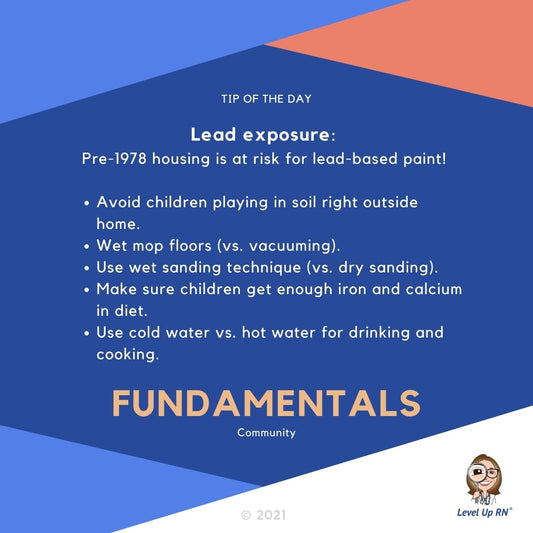
Lead Exposure
Lead exposure: Pre-1978 housing is at risk for lead-based paint! Check out these patient teaching tips.
Lead Exposure
Lead exposure: Pre-1978 housing is at risk for lead-based paint! Check out these patient teaching tips.

Blood Glucose Key Points
Key points when taking a patient's blood glucose: Place hand in dependent position; Pierce outer; Wipe away first drop of blood; Hold test trip NEXT to the blood drop
Blood Glucose Key Points
Key points when taking a patient's blood glucose: Place hand in dependent position; Pierce outer; Wipe away first drop of blood; Hold test trip NEXT to the blood drop

Incidence Vs Prevalence
Incidence vs. Prevalence: Incidence is the number of NEW cases of disease/injury in a population during a period of time. Prevalence is the number of ALL cases (new and pre-existing) of disease/injury...
Incidence Vs Prevalence
Incidence vs. Prevalence: Incidence is the number of NEW cases of disease/injury in a population during a period of time. Prevalence is the number of ALL cases (new and pre-existing) of disease/injury...

Abdominal Wound Dehiscence
For abdominal wound dehiscence with evisceration: Place saline-soaked gauze over wound; Don't try to reinsert organs!; Prepare patient for possible surgery.
Abdominal Wound Dehiscence
For abdominal wound dehiscence with evisceration: Place saline-soaked gauze over wound; Don't try to reinsert organs!; Prepare patient for possible surgery.
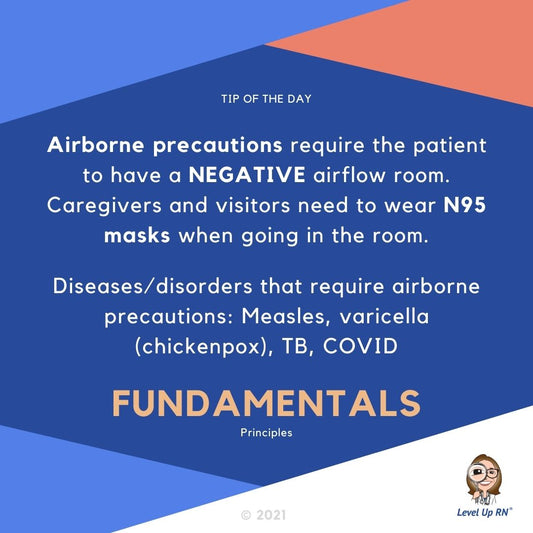
Airborne Precautions
Airborne precautions require the patient to have a NEGATIVE airflow room. Caregivers and visitors need to wear N95 masks when going in the room.
Airborne Precautions
Airborne precautions require the patient to have a NEGATIVE airflow room. Caregivers and visitors need to wear N95 masks when going in the room.

Know your levels of illness prevention!
Know your levels of prevention! Primary, Secondary, Tertiary
Know your levels of illness prevention!
Know your levels of prevention! Primary, Secondary, Tertiary

Applying Restraints
When applying restraints, make sure 2 fingers can fit between restraint and patient, se a quick release knot, and don't place restraints on side rail.
Applying Restraints
When applying restraints, make sure 2 fingers can fit between restraint and patient, se a quick release knot, and don't place restraints on side rail.

Reporting Urine Output
REPORT urine output that is less than 30ml/hr! Decreased urine output can be indicative of shock, sepsis, and kidney failure.
Reporting Urine Output
REPORT urine output that is less than 30ml/hr! Decreased urine output can be indicative of shock, sepsis, and kidney failure.


Enteral Feeding
Enteral feeding: Confirm placement with x-ray; Measure gastric contents; Hold feeding if residual exceeds ~500ml; Flush feeding tubes.
Enteral Feeding
Enteral feeding: Confirm placement with x-ray; Measure gastric contents; Hold feeding if residual exceeds ~500ml; Flush feeding tubes.

Delegating to your CNA
Things can delegate to your CNA/tech partner: Bathing, toileting, dressing, ambulating, positioning, vital signs, bed making, specimen collection...
Delegating to your CNA
Things can delegate to your CNA/tech partner: Bathing, toileting, dressing, ambulating, positioning, vital signs, bed making, specimen collection...
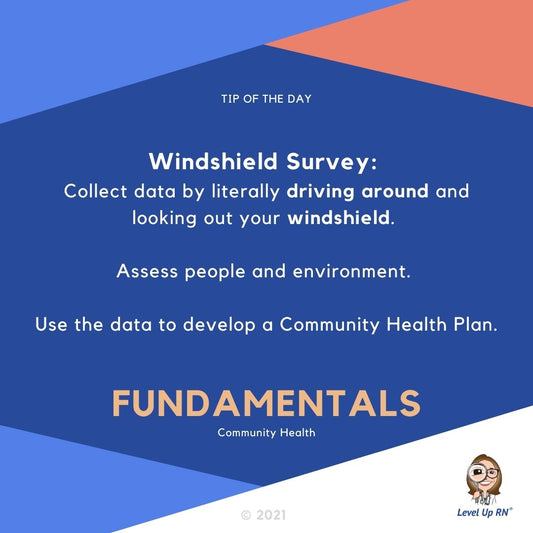
Windshield Survey
Windshield Survey: Collect data by literally driving around and look out your windshield.
Windshield Survey
Windshield Survey: Collect data by literally driving around and look out your windshield.
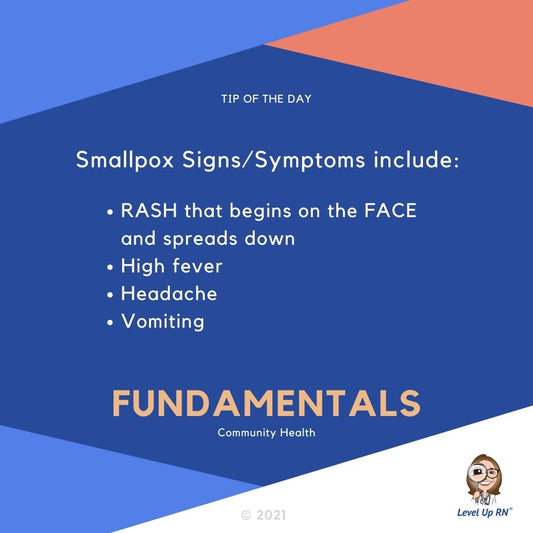
Smallpox Symptoms
Smallpox: Symptoms include a RASH that begins on the FACE and spreads down, high fever, headache, vomiting.
Smallpox Symptoms
Smallpox: Symptoms include a RASH that begins on the FACE and spreads down, high fever, headache, vomiting.
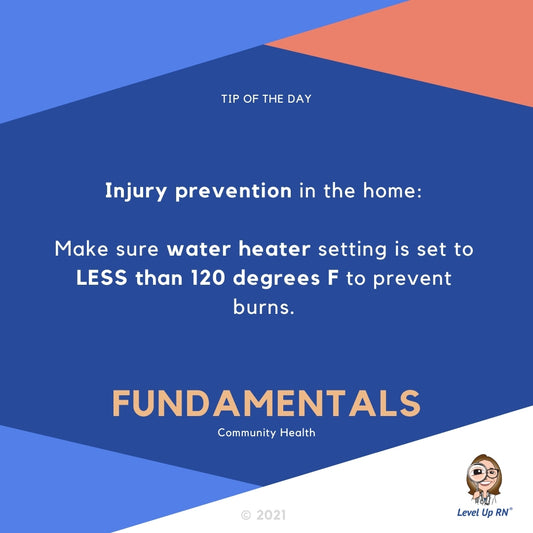
Water Heater Settings
Injury prevention in the home: Make sure water heater setting is set to LESS than 120 degrees F to prevent burns.
Water Heater Settings
Injury prevention in the home: Make sure water heater setting is set to LESS than 120 degrees F to prevent burns.

Community Nursing
Community Oriented Nursing is focused on health promotion and disease prevention in the community. No direct care for individuals! Community Based Nursing is focused on illness care for individuals and families.
Community Nursing
Community Oriented Nursing is focused on health promotion and disease prevention in the community. No direct care for individuals! Community Based Nursing is focused on illness care for individuals and families.
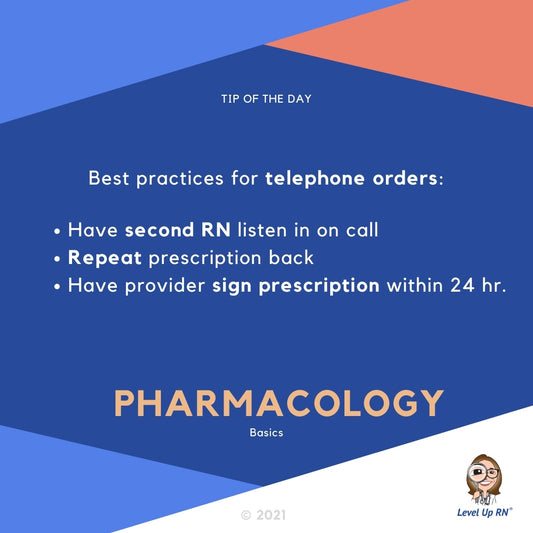

Orthostatic Hypotension
A patient is POSITIVE for orthostatic hypotension if: The SBP decreases more than 20mmHg when changing position AND/OR the DBP decreases more than 10mmHg
Orthostatic Hypotension
A patient is POSITIVE for orthostatic hypotension if: The SBP decreases more than 20mmHg when changing position AND/OR the DBP decreases more than 10mmHg

Enteral feeding tubes
For enteral feeding tubes, flush tubing with 15-30ml of water before, after, and in between medications
Enteral feeding tubes
For enteral feeding tubes, flush tubing with 15-30ml of water before, after, and in between medications

Triage for a Mass Casualty event
Triage for a Mass Casualty event: Class I (red tag), Class II (yellow tag), Class III (green tag), Class IV (black tag)
Triage for a Mass Casualty event
Triage for a Mass Casualty event: Class I (red tag), Class II (yellow tag), Class III (green tag), Class IV (black tag)

Delegating to your PN
Things can delegate to PN: Medication administration, foley catheter, enteral feeding, NG tube insertion, suctioning, tracheostomy care...
Delegating to your PN
Things can delegate to PN: Medication administration, foley catheter, enteral feeding, NG tube insertion, suctioning, tracheostomy care...
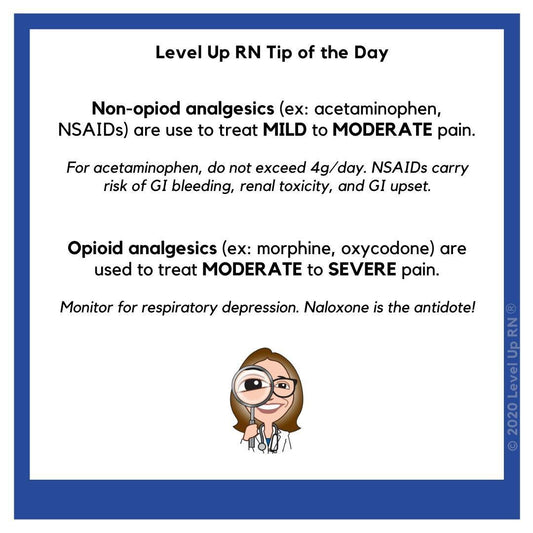
Opioid and Non-opioid Analgesics
Non-opiod analgesics are use to treat MILD to MODERATE pain. Opioid analgesics are used to treat MODERATE to SEVERE pain.
Opioid and Non-opioid Analgesics
Non-opiod analgesics are use to treat MILD to MODERATE pain. Opioid analgesics are used to treat MODERATE to SEVERE pain.

Therapeutic Communication Key Points
Key points about Therapeutic Communication: Avoid asking "Why...?" Ask OPEN ended questions. Don't offer opinion, give false reassurance, or change subject.
Therapeutic Communication Key Points
Key points about Therapeutic Communication: Avoid asking "Why...?" Ask OPEN ended questions. Don't offer opinion, give false reassurance, or change subject.
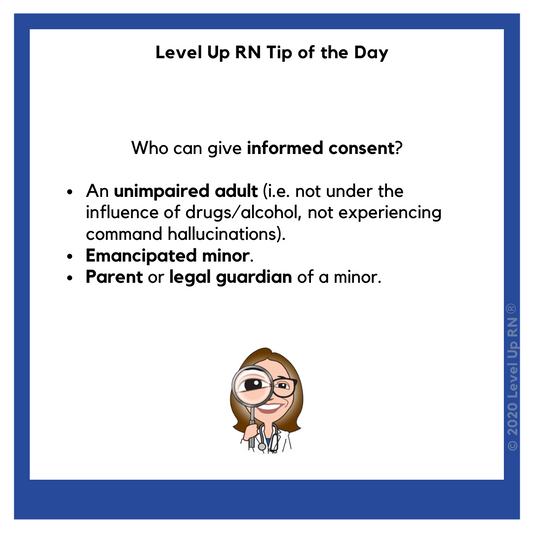
Giving Informed Consent
Who can give informed consent? An unimpaired adult (i.e. not under the influence of drugs/alcohol, not experiencing command hallucinations). Emancipated minor. Parent or legal guardian of a minor.
Giving Informed Consent
Who can give informed consent? An unimpaired adult (i.e. not under the influence of drugs/alcohol, not experiencing command hallucinations). Emancipated minor. Parent or legal guardian of a minor.
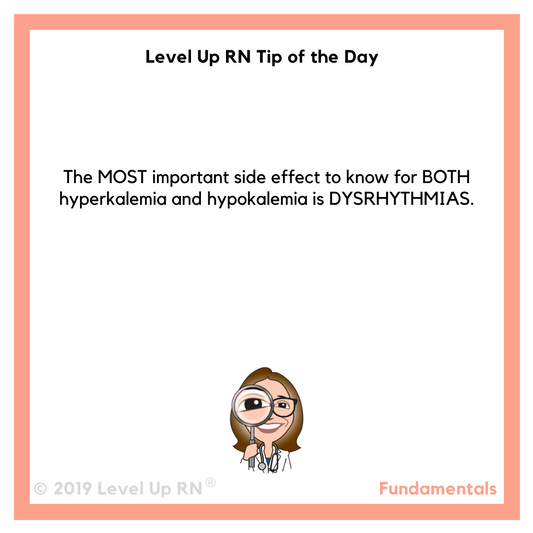
Hyperkolemia & Hypokolemia
The MOST important side effect to know for BOTH hyperkalemia and hypokalemia is DYSRHYTHMIAS.
Hyperkolemia & Hypokolemia
The MOST important side effect to know for BOTH hyperkalemia and hypokalemia is DYSRHYTHMIAS.
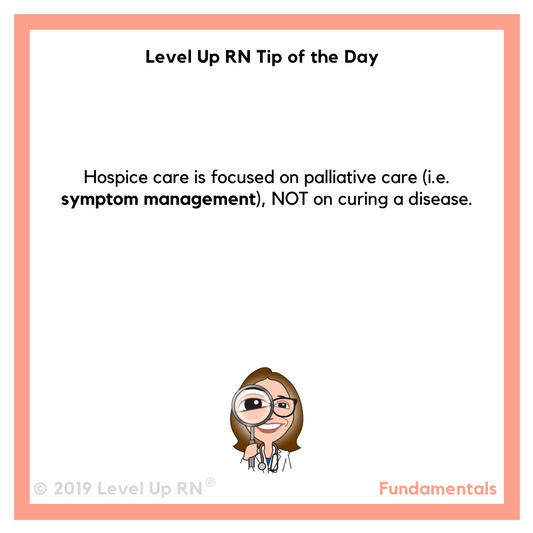
Hospice Care
Hospice care is focused on palliative care (i.e. symptom management), NOT on curing a disease.
Hospice Care
Hospice care is focused on palliative care (i.e. symptom management), NOT on curing a disease.

Types of Immunity
Types of immunity: Active natural: Body produces antibodies in response to exposure to a live pathogen. Active artificial: Body produces antibodies in response to a vaccine. Passive natural: Antibodies are passed from the...
Types of Immunity
Types of immunity: Active natural: Body produces antibodies in response to exposure to a live pathogen. Active artificial: Body produces antibodies in response to a vaccine. Passive natural: Antibodies are passed from the...

BP Cuffs
Blood pressure cuffs: If the cuff is too large, you will get a falsely low reading. If the cuff is too small, you will get a falsely high reading.
BP Cuffs
Blood pressure cuffs: If the cuff is too large, you will get a falsely low reading. If the cuff is too small, you will get a falsely high reading.

Oxygen Safety
Oxygen safety: Use COTTON bedding and clothes (vs. synthetic fabrics or wool).
Oxygen Safety
Oxygen safety: Use COTTON bedding and clothes (vs. synthetic fabrics or wool).

FIRE-RACE
Response to a FIRE: Use the RACE sequence. R = rescue (move patients to safer location). A = alarm (activate alarm system). C = contain (close doors/windows, turn off oxygen...
FIRE-RACE
Response to a FIRE: Use the RACE sequence. R = rescue (move patients to safer location). A = alarm (activate alarm system). C = contain (close doors/windows, turn off oxygen...

Apical Pulse
Apical pulse is taken at the fifth intercostal space at the left midclavicular line.
Apical Pulse
Apical pulse is taken at the fifth intercostal space at the left midclavicular line.

ABCDE Principle
With the ABCDE principle in Nursing, A is for "airway". Ensure the patient has a patent airway AND the cervical spine is stabilized if neck/head trauma is suspected.
ABCDE Principle
With the ABCDE principle in Nursing, A is for "airway". Ensure the patient has a patent airway AND the cervical spine is stabilized if neck/head trauma is suspected.

Left Shift in WBCs
If labwork indicates there is a "Left Shift" in WBCs, this means that the body is fighting an infection and releasing many immature WBCs in response.
Left Shift in WBCs
If labwork indicates there is a "Left Shift" in WBCs, this means that the body is fighting an infection and releasing many immature WBCs in response.
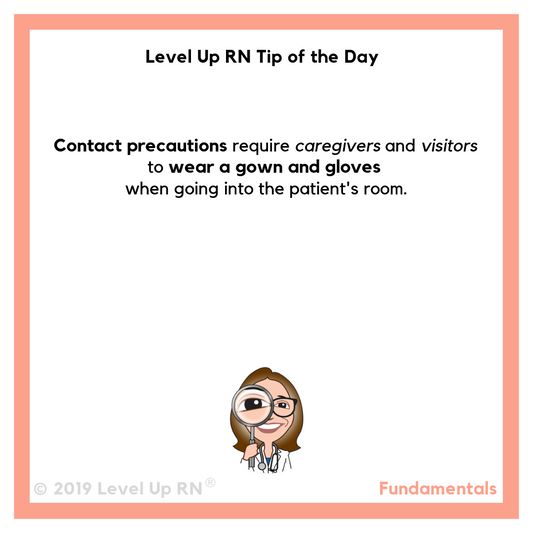
Contact Precautions
Contact precautions require caregivers and visitors to wear a gown and gloves when going into the patient's room.
Contact Precautions
Contact precautions require caregivers and visitors to wear a gown and gloves when going into the patient's room.
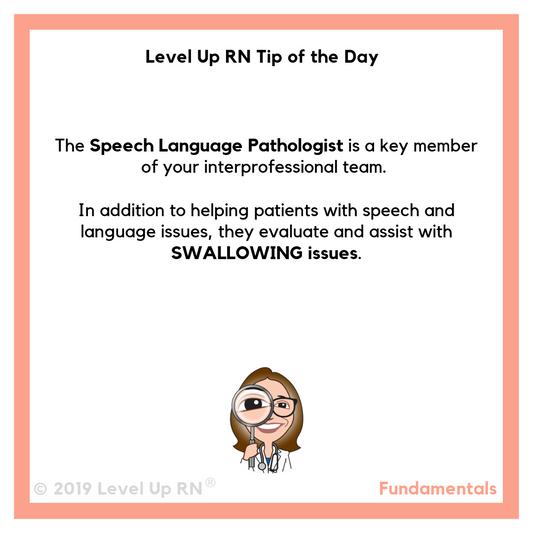
Speech Language Pathologist
The Speech Language Pathologist is a key member of your interprofessional team. In addition to helping patients with speech and language issues, they evaluate and assist with SWALLOWING issues.
Speech Language Pathologist
The Speech Language Pathologist is a key member of your interprofessional team. In addition to helping patients with speech and language issues, they evaluate and assist with SWALLOWING issues.
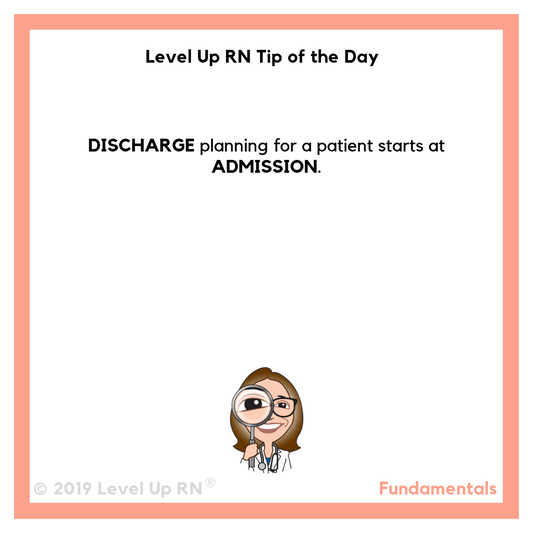
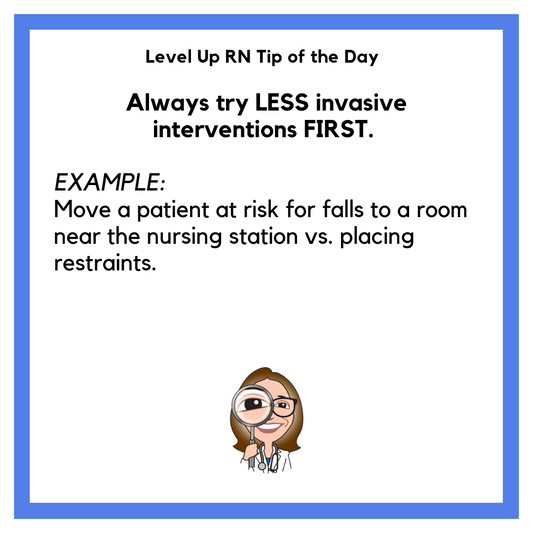
Try less invasive interventions first
Always try LESS invasive interventions FIRST. Example: Move a patient at risk for falls to a room near the nursing station vs. placing restraints.
Try less invasive interventions first
Always try LESS invasive interventions FIRST. Example: Move a patient at risk for falls to a room near the nursing station vs. placing restraints.
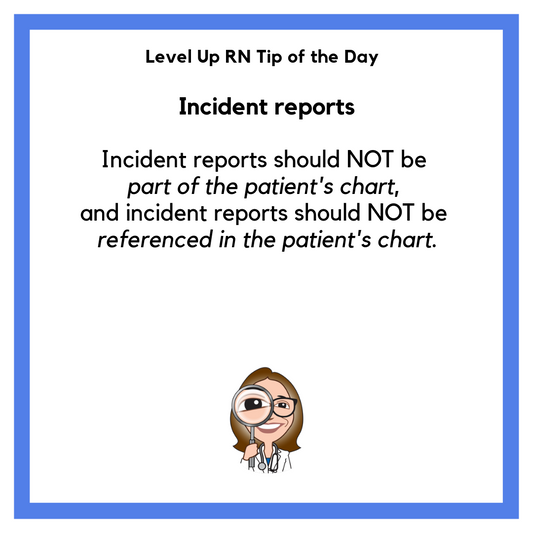
Incident Reports
Incident reports should NOT be part of the patient's chart, and incident reports should NOT be referenced in the patient's chart.
Incident Reports
Incident reports should NOT be part of the patient's chart, and incident reports should NOT be referenced in the patient's chart.
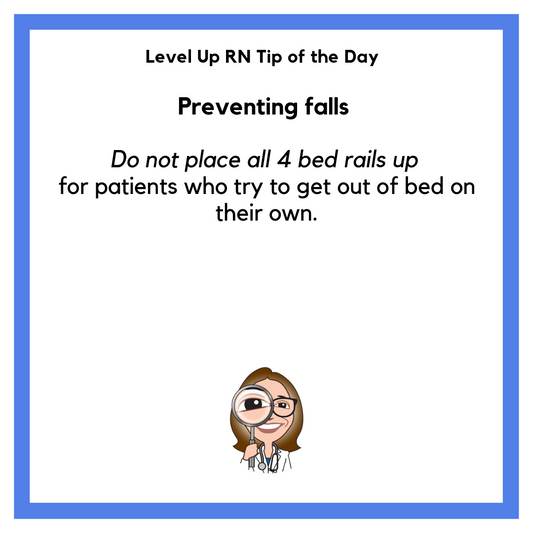
Preventing falls
Preventing falls: Do not place all 4 bed rails UP for patient who try to get out of bed on their own.
Preventing falls
Preventing falls: Do not place all 4 bed rails UP for patient who try to get out of bed on their own.
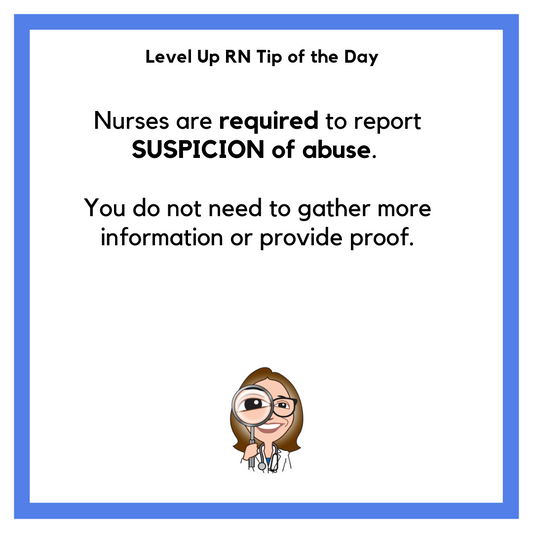
Suspicion of Abuse
Nurses are required to report suspicion of abuse. You do not need to gather more information or provide proof.
Suspicion of Abuse
Nurses are required to report suspicion of abuse. You do not need to gather more information or provide proof.

Informed Consent
In order to give informed consent, a patient must be an unimpaired adult (ex: no drugs, alcohol, hallucinations) or an emancipated minor.
Informed Consent
In order to give informed consent, a patient must be an unimpaired adult (ex: no drugs, alcohol, hallucinations) or an emancipated minor.

Older adult home safety
When assessing HOME safety for older adults, it is important to remove scatter rugs!
Older adult home safety
When assessing HOME safety for older adults, it is important to remove scatter rugs!
Filter Articles
Shop
The Ultimate Nursing School Survival Kit - Flashcards
4.870689655 / 5.0
(232) 232 total reviews
Regular price $314.96Regular priceUnit price / per$469.95Sale price $314.96SaleVideos by Subject
Tips & More
Exam Information
Subscribe


